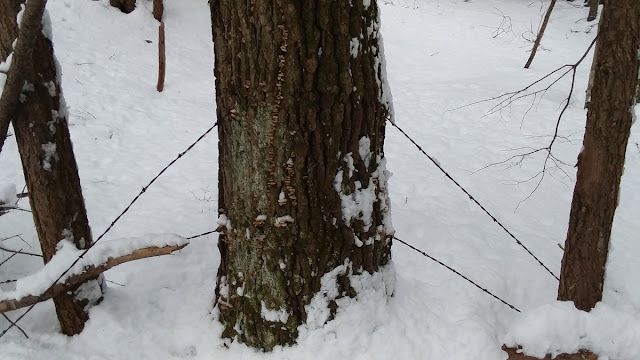transitioned through this
and ended like this.
The 12 to 15 inches of dense snow resurrected the skiing and may have averted an early end to the season for many ski areas.
Fresh, pristine snow always entices me out on the snowshoes, and on Friday I crossed paths with our local bobcat, so I followed it along for a bit as it wound through the woods. It took a good part of a mile before I found a print that was clear enough to confirm I was following the path of our only wild feline.
 |
| The round shape and boomerang foot pad of the bobcat |
Nothing of note was observed from the cat, but one of the perks of following tracks is being taken places you've never been before - or would never go on your own volition: through dense hemlock stands, across (barely) frozen swamps, and up ledges, all of which an 18 inch tall, four pawed creature thinks nothing of traversing.
 |
| Across almost-frozen wetlands |
 |
| Up rocky ledges |
This particular bobcat led me on a trip where I discovered an old relic from New Hampshire's agrarian past.
I love finding these old barb wire fences passing through the center of sizable trees.
I'm no expert on tree aging, but this red oak could easily be 100 or 125 years old, and since the wire is pretty close to the center it means the fence was set when the tree was just a tiny sapling, dating the wire to perhaps the late 1800's. This recalls a different contrast in the New England landscape, one that happened slowly over the better part of a century. A hundred years ago this land as well as most of the Lakes Region and much of New Hampshire was completely cleared of forest for farming, for lumber, and then for grazing. Picture all the land around the lakes as fields rather that forest; it's a stark contrast that happened slowly over so many years it was hardly noticed.
 |
| A typical New England landscape in the late 1800s |
Another tree farther down the fence line has died and almost completely rotted away, again showing the age of the fence.
 |
| Wood around the wire indicates the size of this tree before decay set in |
It appears that scar tissue grown to isolate a foreign object is more rot-resistant than the rest of the tree.
I also found a pretty ambitious pileated woodpecker excavation project.
 |
| It's hard to see, but the bottom is about 3" below the opening |












No comments:
Post a Comment